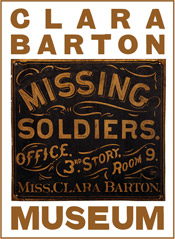Frequently Asked Question: How did Barton get to D.C.?
In 1850, at the age of 29, Clara Barton enrolled at the Clinton Liberal Institute in Clinton, New York, for a year of study. During this time her mother, Sara Barton, died, and Clara visited her friend Mary Norton in Hightstown, New Jersey. While visiting, they went on a trip to Bordentown where Barton was dismayed to see “idle boys. But the boys! I found them on all sides of me. Every street corner had little knots of them, idle, listless, as if to say what shall one do when they have nothing to do?” New Jersey lacked in free public education, instead using private schools and pauper schools to educate the young in the community.
 |
| Barton’s Original Bordentown, NJ Schoolhouse (Wikimedia) |
After finishing her courses in Clinton, Barton moved to Bordentown and said “If you will let me try, I will teach the children for free for six months.” Barton was given a ramshackle one room school house, and by 1853, the school grew from 6 pupils to 600. The citizens of Bordentown, pleased with her accomplishments, raised $4,000 to build a larger school. However, when Schoolhouse Number One opened in the fall of 1853, Clara Barton was not to be the head of the school she founded. A bout of laryngitis had kept her occupied for a few months and in that time a man was hired, at twice her salary, to be the principal of this successful new public school. Barton, hurt by this clear injustice, was “willing to teach for nothing, but if paid at all, I shall never do a man’s work for less than a man’s pay.”
 |
| Washington D.C. circa 1850’s (dickinson.edu) |
There are a number of reason why Barton goes to Washington D.C. She mentions that she wanted “the mild air for my throat” and that D.C. was as far south as a single, unaccompanied woman could go – perhaps a nod to her staunchly Northern sensibilities. She also attested that she was interested in politics and the Library of Congress as a resource for study. She quickly made the acquaintance of a congressman from her home district and distant cousin, Alexander DeWitt. Through this contact she began to broaden her circle of acquaintances in D.C. to include Mr. Charles Mason, the United States Commissioner of Patents. They became friends and, originally, Mason hoped to employ Barton as a governess for his twelve year old daughter, Mary. However, with some persuading on the part of DeWitt, a private carriage ride to the Patent Office, and an interview, Mason hired Barton as a temporary clerk at the Patent Office in July of 1854.
 |
| U.S. Patent Office circa 1850 (now the American Portrait Gallery) |
As a clerk, Barton was paid $1400 a year to copy patent applications, caveats, and regulations – the same salary as a male clerk. When Barton began, she only knew of four other female clerks in the federal employ, although, after only a year, there were four working in the Patent Office alone! However, this positive atmosphere was not to last. Mason retired from the Patent Office in July of 1855 to return to his farm in Iowa, and his replacement, Mason’s former chief clerk Samuel T. Shugert, was eager
 |
| Charles Mason |
to please Secretary McClelland, who wanted only men in the federal employ. Barton was demoted immediately from recording clerk to copyist, who made 10 cents for every 100 words copied. Even the best could only make around $900 per year. Barton and the other women in the office were given no work to do and sat idle and without an income for July, August, and September. Despite the letters written on her behalf by Mason, DeWitt and others, Secretary McClelland was determined to stop women from working within the four walls of the Patent Office. So, in October, Barton took her work home, picking up and dropping off her work at the Patent Office, and managed to make $73.56 that month, more than most copyists.
 |
| Alexander DeWitt (wikimedia) |
she was exhausted from the driving work pace, intermittent bouts of malaria, and the sexism and rumors that prevailed about her from her male colleagues that ranged from affairs with her boss to illegitimate children with African American features. Her best allies were also fading from view – Congressman Dewitt was not reelected in 1857 and left the District, and Mason resigned from the Patent Office for good in August of that same year. A month later, in September of 1857, Barton was told her position at the Patent Office was wanted, and so she returned north to Massachusetts only to return to Washington D.C. a mere three years later and take up lodging at our location on 7th Street for the next eight years.

